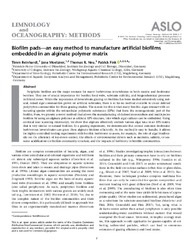Biofilm pads—an easy method to manufacture artificial biofilms embedded in an alginate polymer matrix
DOI: https://doi.org/10.1002/lom3.10339
Persistent URL: http://resolver.sub.uni-goettingen.de/purl?gldocs-11858/8959
Persistent URL: http://resolver.sub.uni-goettingen.de/purl?gldocs-11858/8959
Reinhardt, Timm; Moelzner, Jana; Neu, Thomas R.; Fink, Patrick, 2019: Biofilm pads—an easy method to manufacture artificial biofilms embedded in an alginate polymer matrix. In: Limnology and Oceanography: Methods, Band 18, 1: 1 - 7, DOI: 10.1002/lom3.10339.
 |
Dokument öffnen: |
Periphytic biofilms are the major resource for many herbivorous invertebrates in both marine and freshwater benthos. They are of crucial importance for benthic food webs, substrate stability, and biogeochemical processes in littoral zones. While the importance of invertebrate grazing on biofilms has been studied extensively using natural, mixed algal communities grown on artificial substrates, there is so far no method available to create defined periphyton communities for these grazing studies. The reason for this is that many benthic algae interact with co-occurring species within the extracellular polymeric substances (EPSs) that form the nonorganismic part of the biofilm. Here, we present a novel method that allows the manufacturing of defined monoculture and multispecies biofilms by using an alginate polymer as artificial EPS structure, into which algal cultures can be embedded. Using confocal laser scanning microscopy, we show that alginate effectively embeds various algal taxa in an EPS matrix that is very similar to natural biofilms. In a grazing experiment, we demonstrate that several common freshwater herbivorous invertebrates can graze these alginate biofilms efficiently. As the method is easy to handle, it allows for highly controlled feeding experiments with benthic herbivores to assess, for example, the role of algal biodiversity on the efficiency of top-down control, the effects of environmental drivers such as nutrients, salinity, or seawater acidification on biofilm community structure, and the impacts of herbivory in benthic communities.
Statistik:
ZugriffsstatistikSammlung:
This is an open access article under the terms of the Creative Commons Attribution-NonCommercial License, which permits use, distribution and reproduction in any medium, provided the original work is properly cited and is not used for commercial purposes.

